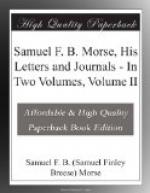“It is astonishing that with such works of the old masters before them as the Italians have, they should not perceive the defects of their own painters in this particular. Cammuccini is the only one among them who possesses genius in the higher departments, and he only in drawing; his color is very bad.
“A funeral procession passed the house to-day. On the bier, exposed as is customary here, was a beautiful young girl, apparently of fifteen, dressed in rich laces and satins embroidered with gold and silver and flowers tastefully arranged, and sprinkled also with real flowers, and at her head was placed a coronet of flowers. She had more the appearance of sleep than of death. No relative appeared near her; the whole seemed to be conducted by the priests and monks and those hideous objects in white hoods, with faces covered except two holes for the eyes.”
In early May, Morse, in company with other artists, went on a sketching trip to Tivoli, Subiaco, Vico, and Vara. This must have been one of the happiest periods of his life. He was in Italy, the cradle of the art he loved; he was surrounded by beauty, both natural and that wrought by the hand of man; he had daily intercourse with congenial souls, and home, with its cares and struggles, seemed far away. His notebooks are largely filled with simple descriptions of the places visited, but now and then he indulges in rhapsody. At Subiaco he comes upon this scene:—
“Upon a solitary seat (a fit place for meditation and study), by a gate which shut the part of the terrace near the convent from that which goes round the hill, sat a monk with his book. He seemed no further disturbed by my passing than to give me the usual salutation.




